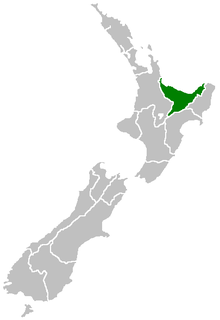Bay of Plenty Region
| Environment Bay of Plenty Bay of Plenty Regional Council | |
| Country: | New Zealand |
 | |
| Regional Council | |
|---|---|
| Name: | Environment Bay of Plenty |
| Chair: | John Cronin |
| Population: | 262,900 June 2006 estimate |
| Land Area: | 12,277 km² |
| Website: | http://www.envbop.govt.nz |
| Cities and Towns | |
| Cities: | Tauranga, Rotorua, Whakatane |
| Towns: | Te Puke, Taneatua, Edgecumbe, Opotiki, Kawerau, Murupara, Ohope, Matata, Maketu, Ngongotaha |
| Constituent Territorial Authorities | |
| Names: | Tauranga City Part of Rotorua District Whakatane District Western Bay of Plenty District Kawerau District Opotiki District Part of Taupo District |
| Websites: | http://www.tauranga.govt.nz http://www.rdc.govt.nz http://www.whakatane.govt.nz http://www.wbopdc.govt.nz http://www.kaweraudc.govt.nz http://www.odc.govt.nz |
The Bay of Plenty (Māori: Te Moana-a-Toi), often abbreviated to BoP, is a region in the North Island of New Zealand situated around the body of water of the same name. The largest city in the Bay of Plenty is Tauranga, in the Western area.
The bay itself
The bay stretches from the base of the Coromandel Peninsula in the west to Cape Runaway in the east. The region is bound by the Kaimai and Mamaku Ranges in the west and extends inland to the sparsely populated forest lands around Rotorua, Kawerau and Murupara. Several islands are located in the bay, notably Mayor Island/Tuhua, Motiti Island, Whale Island and, most famously, the active volcano of Whakaari/White Island.
The bay was named by James Cook some time during November 1769. Cook named it the Bay of Plenty after he noticed the abundant food supplies at several Māori villages he visited on the coast, in stark contrast to the observations he had made earlier in Poverty Bay.
The region
The local government region has a 2006 estimated population of 257,379 [1], which is projected to increase to 277,900 by the year 2011. The region is dominated by two cities: Tauranga (population 103,635)[1] and Rotorua (population 65,901)[1]. As a compromise between the cities, in 1989 the town of Whakatane was selected as the seat for the Bay of Plenty Regional Council, although in 2007, it was decided that Tauranga would take this role [2]. Other towns in the region include Te Puke, Kawerau, Katikati and Opotiki. Agriculture and tourism are the region's two main industries, with the geothermal region around Rotorua being a popular tourist destination.
The area is forested, much being commercially planted and managed, and the region has extensive agriculture. The climate in coastal areas is nearly tropical, being both humid and warm most of the year, inland though within the Rotorua area the average temperature is generally 2 °C cooler. Notable crops are kiwifruit, apples, avocados and timber. As with most of New Zealand, sheep farming is common, although increasingly dairy and beef farming are replacing sheep.
Increasingly the road infrastructure, notably in the Western Bay of Plenty, is becoming stretched due to a reliance on road transport for moving logs to the main port in Tauranga. Train lines, in particular the East Coast Main Trunk Railway exist between Tauranga and the Waikato region and through to the Eastern bay region, these used exclusively for freight.
Demographics
The total resident population of the Bay Of Plenty region at the time of the 2006 Census was 257,379.
Of those, 28 per cent said they belonged to the Māori ethnic group. Twenty-three per cent were under the age of 15 years and 3.9 per cent were unemployed.
Largest Cities/Towns
- Tauranga 111,500
- Rotorua 54,900
- Whakatane 18,850
- Kawerau 7,100
- Te Puke 7,050
- Opotiki 4,000
- Katikati 2,950
